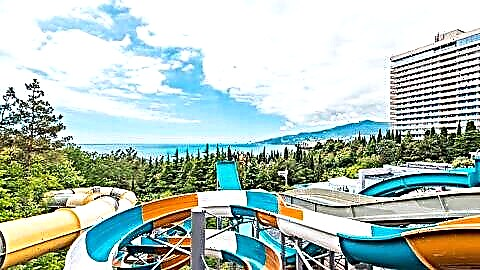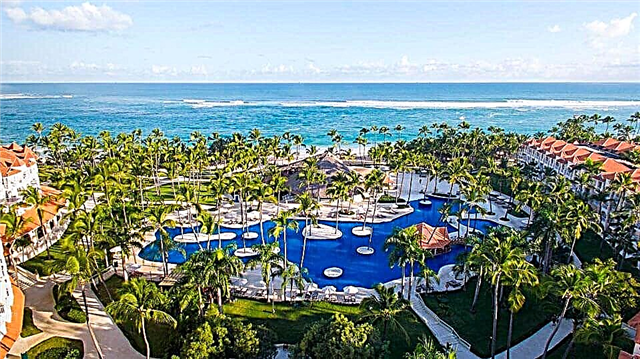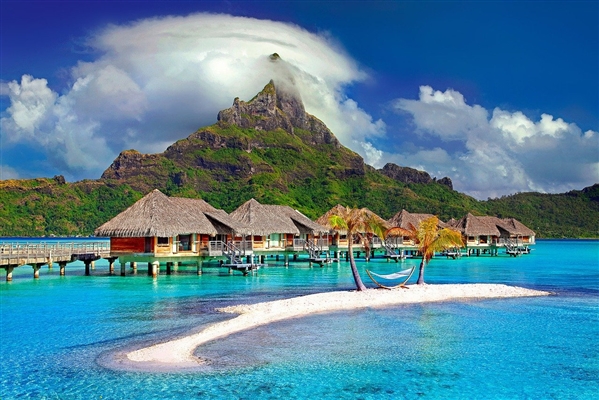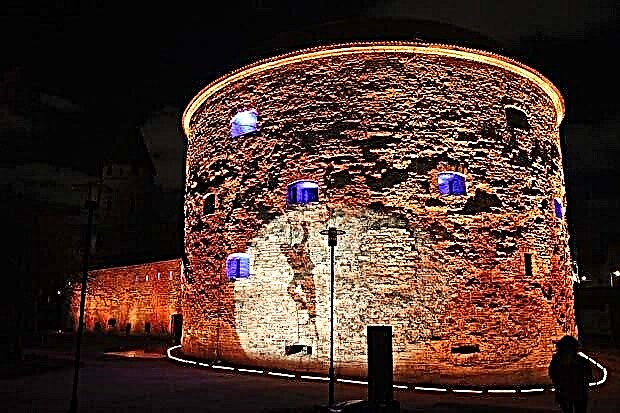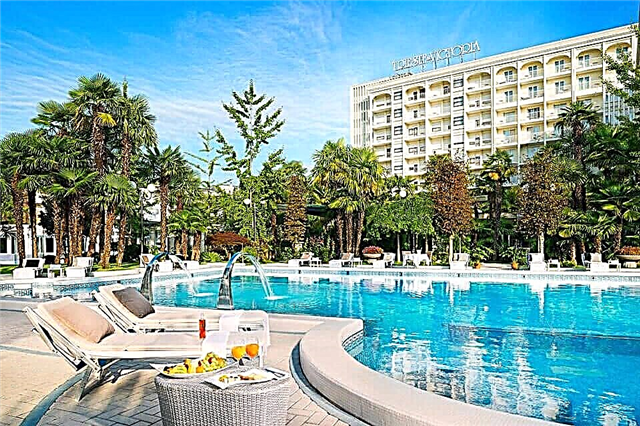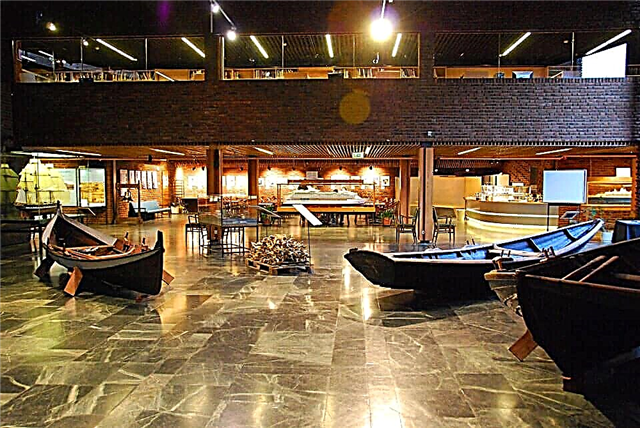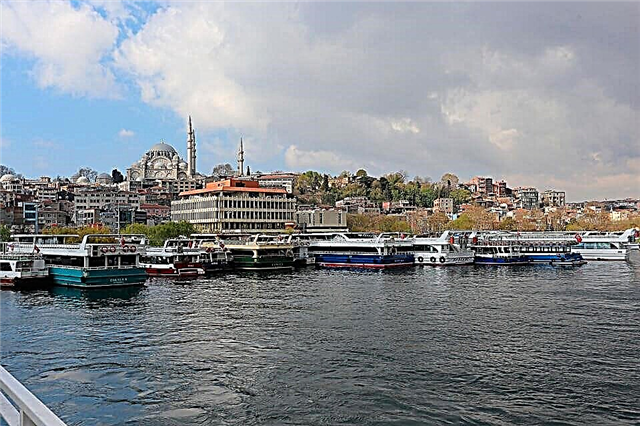Today we will have a rich and very exciting walk through one of the most beautiful cities in Turkey. Let's talk about the most popular sights of Istanbul, which better than any guide will tell you about the history of this unique city. The walk promises to be intense and very exciting.
Haydarpasha station

The starting station of the Istanbul-Baghdad railway. It is located in the Kadikoy district, on the Asian side of Istanbul. Construction of the station building began on May 30, 1906 and ended on August 19, 1908. The official opening took place on November 4, 1909.
The complex was built by a German company in the neo-Renaissance style. In addition, the Germans built a breakwater transshipment complex, on which wagons from Asia were reloaded onto merchant ships and ferries. The building was a gift from Emperor Wilhelm II to Sultan Abdul-Hamid II. Haydarpash station was damaged and repaired three times. The first time was in 1917, when a fire broke out at an ammunition depot.
On November 15, 1979, a dry cargo ship and a tanker collided 800 meters from the station. Explosions and fires following the accident caused serious damage to the train harbor building. Its renovation was completed in 1983. On November 28, 2010, a fire broke out on the roof of the structure, and it collapsed. Recovery work after this incident lasted about a year.
Near the station is the railway workers' mosque of the same name. It was built on the site of the destroyed Gregorian church in 1874. The temple is decorated in a Baroque style and is decorated with 2 minarets. Boats that carry passengers across the Bosphorus dock at the pier near the station. Car ferries of the Ilyichevsk-Istanbul line are also unloaded at the pier. You can get to Khadarpasa station by boat from Bostanci, Yenikapi and Kadikoy marinas, as well as by metro line M4 (Ayrılıkçeşme stop).
Galata tower

Galata Tower is a landmark that can be seen from anywhere in the city. It was erected on the hill of the same name in the XIV century. The construction was built by the Genoese who inhabited one of the districts of Constantinople. At the time of the completion of the construction, the Galata Tower was the largest building of the Byzantine capital.
At the beginning of the 16th century, Galata was used as a prison for Christian prisoners of war, and in the middle of the century, an astronomical observatory was located on its upper platform. The latter was closed in 1578. In 1632, the scientist Hezarfen Ahmet елelebi made eagle-like wings and jumped from the tower.
He flew over the Bosphorus and landed in the Asian part of the city. The Sultan first rewarded the daredevil, and later sent him to Algeria. The flight generated great interest in Europe. It has been painted by the best artists of the Old World many times.
The tower was repaired in 1791, 1832 and 1875. It housed an observation post from which soldiers monitored the outbreak of fires and riots in the European part of the city. In 1964-1967, Galata underwent restoration and acquired a modern look; a dome was erected on its top. In the early 2000s, an elevator was built in the building. Several dozen people committed suicide from the walls of the tower.
Features of the structure:
- Height - 69.9 meters
- Wall thickness - 3.75 meters
- Outside diameter - 16.45 meters
- Weight (according to calculations) - about 1000 tons
The following works in the Galata Tower:
- Museum
- Night club
- A restaurant
The museum is open from 9 am to 8 pm. Several dozen accommodation and catering establishments are located within a radius of 100 meters from the building. You can get to the Galata Tower on foot or by car. There is a funicular from the old city of Sultanahmet to Meshrutiyet Street (200 m from the building). There is also the Sishane station of the M2 metro line.
Blue Mosque

It was built in 1609-1616 by order of the 14th Sultan of the Ottoman Empire. He allocated money for the construction from his treasury. For the construction of the mosque, several palaces of the highest dignitaries of the state and the large palace of the Byzantine emperors were destroyed. The architecture of the temple is a combination of the best features of the Ottoman and Byzantine styles.
The domes of the mosque are decorated with celestial tiles. For this design, it is called blue. The special features of the temple are 6 minarets. 4 of them are oriented to the cardinal points, and 2 are in the outer courtyard of the building. More towers were built only near the Masjid al-Haram mosque in Mecca. The interiors of Sultanahmet are decorated with floral ornaments. The central hall of the building is 53 meters long and 51 meters wide. The dome above it has a diameter of 23.5 meters.
In the niche of the wall, which faces Mecca, there is a black stone from the holy city for Muslims. In the western part of the mosque there is a special entrance for the sultan with a chain. The bow that the ruler made in order to pass under it symbolized his insignificance before God. A mosque is a whole complex of buildings. Its buildings house a temple, primary and religious schools, a nursing home, the tomb of Sultan Akhmet, baths, shops, fountains. Part of the building's premises is leased to private enterprises.
Over its 400-year history, the mosque has repeatedly suffered damage from fires and civil unrest. Each time the rulers of Turkey allocated money for its restoration. In 1826, the headquarters of the Grand Vizier was located in the temple, who suppressed the uprising of the Janissaries and liquidated the Janissary corps. The mosque is open to the public from 8:30 am to 12:30 pm, from 2:00 pm to 4:45 pm and from 5:45 pm to 6:30 pm daily. On Fridays (Muslim days off), the mosque is closed. The entrance is always free. You can get there by high-speed tram line T1. You need to get off at the Sultanahmet stop.
Topkapi Palace

The complex of buildings, which for 380 years was the administrative center of the Ottoman Empire and the residence of its powerful rulers. 25 sultans lived in it. In 1854, Sultan Abdul-Majid I moved to the Dolmabahce Palace. In 1923, by order of Mustafa-Kemal Ataturk, the residence of the head of state was transferred from Topkapi to the Yildiz Palace. At the same time a museum was created in the complex.
The total number of its exhibits exceeds 600,000 items. The construction of the palace began in 1465 by order of Sultan Mehmed II, the conqueror of Istanbul. Each ruler who lived in the residence rebuilt it and added new elements and decorations to its design. The palace is a mixture of several architectural styles that developed in the 15th-19th centuries.
Topkapi consists of 4 gates and courtyards, each of which is a separate complex of structures. In the first of them - the gate of the sovereign, there were service premises. In the second, the greeting gate housed a sofa (the cabinet of ministers) and the treasury, in the third, the gates of happiness housed a harem, the sultan's bedchamber and an elite school of leaders, in the fourth religious and ancillary buildings were erected - a mosque, a circumcision pavilion, a dressing room.
The museum is open from 9 am to 7 pm in the summer (15 April-30 October) and from 9 am to 5 pm in the winter (30 October-15 April). The complex has 2 cafes and 1 restaurant. The palace is located on Cape Sarayburnu, at the junction of the Golden Horn Bay with the Sea of Marmara. T1 trams run to the Gulhane stop, 100 meters from the entrance to the museum. Sikerjee Train Station is 1 km away.
Saint Sophie Cathedral

The architects of Kievan Rus and the Russian Empire tried to copy it several times. The architectural solutions used in the construction of the cathedral are still in use. Since 1985, the Hagia Sophia has been included in the UNESCO heritage list.
The temple was erected in the middle of the 6th century AD by order of the Emperor Constantine. For the construction of the structure, the best materials were brought from all parts of the Byzantine Empire.Marble and columns were taken from the ruins of ancient cities in Syria, Egypt, Athos and North Africa. In the Cathedral of St. Sophia, in 1054, the legates of the Pope announced the deposition of the Patriarch of Constantinople, Kirularius, which split the Christian church into Orthodox and Catholic.
Until 1204, the Shroud of Turin was kept in the temple - a piece of cloth in which the body of Christ was wrapped after the crucifixion. After the sack of Constantinople in 1204, the shrine disappeared without a trace and was found only 150 years later. In 1453, after the capture of Constantinople by the Turks, the cathedral was turned into a mosque and for about 100 years was the main temple of the capital of the Ottoman Empire.
In accordance with the prohibition of Islam on the depiction of people, frescoes and mosaics were covered with plaster. It is thanks to this that they have survived to this day and now delight the eyes of visitors to the building. A small room for Muslims' prayers operates in it now.
In 1935 Hagia Sophia was declared a museum. From April 15 to October 25, it is open from 9 to 19 hours, from October 25 to April 15, it is open from 9 to 17 hours. To get to Hagia Sophia, take the T1 tram and get off at the Sultanahmet stop. From it, walk about 200 meters to the temple.
Sultanahmet

The main square of the city. Since the 4th century AD, it has housed a hippodrome - a place for horse races, chariot races, athletes' competitions and gladiator battles. It was 400 meters long and 150 meters wide. The building could accommodate about 100,000 spectators. The stadium was decorated with a gilded bronze quadriga. After the destruction of Constantinople by the knights in 1204, it was taken to the Cathedral of Santo Marco in Venice, where it is kept to this day.
Among other celebrations at the hippodrome, the sons of Suleiman the Magnificent and Roksolana Hürrem were circumcised. The racetrack was finally destroyed in the 17th century. The structure was depicted on 500 lire banknotes, which were in circulation from 1953 to 1976. There are 3 monuments on the square: the serpentine column, the obelisk of Constantine and the German fountain.
The first is a symbol of the victory of the Greeks over the Persians in the 5th century BC. The second was erected in honor of Emperor Basil I by his grandson Constantine VII. The column is 21 meters high. According to the chronicles, it was lined with sheets of copper, which were stolen by the crusader knights. The fountain is a gift from the German Emperor Wilhelm. Inside it is decorated with gold mosaics and monograms of the rulers of Germany and Turkey.
In 1826, the Janissaries were executed in Sultanahmet Square, who, like the archers in Russia, rebelled against the reforms of their ruler. Also from this place, an uprising began, which led to the overthrow of Sultan Abdul-Hamid II in 1909. In 1950-1951, excavations were carried out on the territory of the former hippodrome. During the research, many artifacts from the Byzantine and early Ottoman empires were found. You can see them in museums. Sultanahmet Square is located in the area of the same name, in the historical center. There is a T1 tram stop next to it.
Beylerbeyi Palace

It was erected in 1861-1865 by the Armenian architects Agop and Sarkis Balyan. The name of the building in translation means "lord of the lords". The title of Beylerbey was awarded only to the best generals, naval commanders and governors of Turkey. Beylerbey's design was designed by Sarkis Balyan in the style of the second French empire. The palace seems rather modest in comparison with the Dolmabahce or Kucuksu chambers. One of the most beautiful decorations of Beylerbey is the reception hall with a pool and a fountain.
Cold water plays the role of thirst quencher, natural air conditioner and interior details. The floor coverings are Egyptian reed mats and Hereke type carpets. The palace is equipped with Bohemian crystal chandeliers. On the alleys of the garden there are Japanese, Chinese, Turkish porcelain vases.
It is better to look at the palace from the side of the Bosphorus during a boat trip. From there you can see 2 bathing pavilions of the complex: a woman's and a man's. They are decorated with Turkish-style floral designs. The palace was used to accommodate guests of the rulers of Turkey. In 1869, it was visited by the Empress of France Eugénie.
She was delighted with the elegance of the building's interiors and how skillfully architects and designers created a replica of her bedroom from the Tuileries castle. In the building, the Empress met with the Valide (mother of the Sultan). The Duke and Duchess of Windsor also visited Beylerbey. Sultan Abdul-Hamid II was held and died in the castle in 1912-1918.
The palace is open every day except Mondays and Thursdays from 9 am to 4 pm. Near the palace there is a pier to which ferries of the Bosphorus line 1 run.
Dolmabahce Palace

It was the administrative center of the Ottoman Empire in 1853-1889 and 1909-1922. Dolmabahce is the first sultan's palace built in the European style. It took 11 years to build - from 1842 to 1953. The chief architect of the building is the Armenian Karabet Balyan. The cost of the palace was equal to the price of 35 tons of gold (approximately 1 billion 180 million dollars in modern money).
For construction, materials were brought from all over the world. Marble - from the island of Marmara, alabaster - from Egpit, porphyry - from Pergamum. The total area of the building is 45,000 m2. It contains 285 rooms, 46 corridors, 6 baths, 68 toilets and 1427 windows.
The main decoration of the palace is a huge crystal chandelier with 750 candles weighing 4 tons. It was presented by Queen Victoria of England. The palace houses the world's largest collection of candle chandeliers.
There is also a Russian trace in Dolmabahce. On one of its walls hangs the skin of a polar bear, which the Turks repainted brown to protect it from dust. Ivan Aivazovsky painted 40 Bosphorus landscapes for the palace. In addition to money, the artist's award was the Order of Osman, the highest award of the empire.
8 sultans of the Ottoman Empire lived and worked in the palace. Mustafa-Kemal Ataturk also lived there. The bed on which the reformer died on November 10, 1938 is kept in the building to this day. She is an object of worship for the majority of Turkish citizens. All chronometers in the building show the time of his death - 9 hours 5 minutes in the morning. In 1887, the German Emperor Wilhelm II visited the palace.
The palace is open to the public every day, except Mondays and Thursdays, from 9 am to 4 pm. You can get there by funicular (Macka station) or by ferry (Besiktas pier).
Maiden's Tower

A construction on a small island in the Bosphorus, near the Uskudar district of the Asian side of Istanbul. She is one of the symbols of the city. Legends are associated with both names of the tower. According to one of them, the young man Leander swam across the Bosphorus every night and found his way through the fire that the girl Gero lit. Once the wind blew out the flames and Leander died.
In the morning, Gero saw his body and jumped from the tower to always be with her beloved. According to a Turkish legend, once there was a good sultan who performed 5 obligatory and 5 additional prayers every day. The dervish who appeared in a dream told the ruler that his beloved odalisque would soon give him a daughter and the girl would be bitten by a snake. The wanderer advised the Sultan to build a tower in the Bosphorus where his daughter would be safe.
A Persian prince who wanted to marry her turned to a flower seller. The sultan agreed to show the plants to the girl, on condition that the merchant's daughter would deliver them. The prince changed into women's clothes and presented a bouquet to the beauty. But a snake crawled out of the flowers and bit the girl. The Persian fell to the wound of his beloved and sucked out the poison. As a reward, he received permission from the Sultan for the wedding.
The Maiden Tower is depicted in Aivazovsky's painting "View of the Leander Tower in Constantinople" and the 10 lire note, which was in circulation in 1966-1981. The Maiden's Tower was built during the Byzantine Empire as a small fort at the entrance to the Golden Horn harbor. Throughout its long history, it has been used as a lighthouse, prison, isolation ward for the sick.
More than once the structure was burnt out and destroyed by earthquakes.But there was always a nobleman who gave money to restore the building. In 1999, the tower was reconstructed and opened to tourists. Now it houses a restaurant, an observation deck and a gift shop. Boats run from the Katabash and Yuskudar berths to the tower.
Titanic city taksim
Just 5 minutes walk from Taksim Square
394 Reviews
based on Very good 8.3

Opera Hotel Bosphorus
Rooftop pool and restaurant
based on Very good 7.8

Swissotel The Bosphorus Istanbul
With stunning views of the Bosphorus
922 reviews
based on Very good 9.0

Suleymaniye Mosque

The Suleymaniye Mosque was built in 1550-1557 by order of the 10th Sultan of the Ottoman Empire, Suleiman the Magnificent. The mosque was named after him. The construction was supervised by the best architect of his time - Sinan-aga. As a reward, he received a golden key - a symbol of the ruler's trust.
The mosque is surrounded by 4 minarets. They show that Suleiman is the 4th sultan after the conquest of Istanbul. There are 10 balconies built on the towers, since Suleiman is the 10th sultan in the Ottoman dynasty. According to one of the legends, the Persian Shah Tahmasp sent precious stones to the construction of the mosque, but Sinan buried them in the base of one of the minarets.
Area - 4500 m2. This is enough to accommodate more than 5,000 people during prayer. The complex of buildings includes a hammam, a school of theology, a caravanserai, and a medical school. On the southern (facing Mecca) side of the mosque, there is a fountain for ablution before prayer. Inside there is a mihrab, a marble niche for singers and plaques with the names of prominent Muslims.
There is a cemetery at the rear of the complex. The nobles of the Ottoman Empire are buried there. The most beautiful tombs of the necropolis are the sarcophagi of Suleiman the Magnificent, his wife Roksolana and their daughter Mihrimah. In the decoration of the tombs, emeralds were used - the favorite stones of Roksolana and rubies - the favorite crystals of Suleiman - were forgotten. A 5-minute walk is the Eminonu stop of the T1 tram line.
Hammam Hurrem Sultan

The traditional Turkish bath complex is built according to the classical requirements of the Ottoman bath architecture. The attraction is considered the most popular bath complex. It was built in 1557 by order of Sultan Suleiman to his beloved wife Khyurrem (Roksolana). There are three departments in the building: hot (hararet 50 ° with hebektashi marble floor), relaxation room, massage rooms, VIP rooms. Two departments function independently: male, female, with separate entrances (they are mirror images).
The interior decoration of the hammam is striking in its beauty and luxury. After the restoration (the bathhouse served for a long time for other purposes not typical for it), everyone can visit it, having reserved a place in advance (in the future, this money will be included in the payment for the procedures). You can get to the Hurem hammam by tram to the Sultanahmet stop.
Palace of Ibrahim Pasha

The palace, reminiscent of an ancient defensive structure, amazes with its grandeur, mystery, permeated with the historical spirit of the Ottoman Empire, the life of the famous sultan and his vizier Ibrahim Pasha. Initially, the building belonged to Suleiman, who owns colossal wealth and power. The closest childhood friend, the husband of Suleiman's sister, was worthy of a priceless gift. The fate of the chief vizier led to a change in the owners of the palace, its purpose (prison, sewing workshops, barracks).
The building was restored in 1983. It houses the Museum of Turkish, Islamic Art. The expositions include ancient manuscripts, treasures, handicrafts (carpets, clothing, jewelry). Household items made of ceramics, wood, precious metals. The palace is located at Sultanahmet district, At Meydani, 46.
Mosque Mihrimah Sultan

In this building, the love of the great sultan, beauty, the greatness of the spiritual qualities of an amazing woman (who is of second importance after the famous Roksolana) are forever frozen. At the highest point of the city (the Sixth Hill), a building appeared, built by the famous architect Sinan (in love with Mihrimah). It became a symbol of medieval architecture, reflecting the "golden age" of the empire. The mosque, penetrated by the sun, amazes with its lightness and grace created by the numerous stained-glass windows.
The ensemble includes the main building, a madrasah, a hammam, several shops, a turbot, a courtyard with a fountain for ablution, and a single minaret. Opposite the mosque is the building of the same name in Uskudar. Once a year (on the birthday of Mihrimah on March 21), at the time of sunset, the moon appears behind the minaret of the mosque, rising from behind another minaret. There is a health center, the tombs of the sons of Mihrimah are preserved. You can get there by bus, metro.
Shehzade Mosque

This amazing building is often referred to as the architectural excellence created by the famous Sinan. It is not inferior in beauty and grandeur to the city's blue mosque. For the first time during the construction of the mosque, the idea of a composite dome was implemented. The building stands on four plinths covered with a dome supported by other (smaller) four domes. The aim of the architectural innovations was to create a room flooded with bright sunlight. A new technique for decorating the mosque was the use of face painting.
A mosque rises on one of the hills of the city. The front facade of the mosque looks at the Golden Horn. Two minarets are decorated with patterns. There is a pool under the foundation that helps to create the right temperature in the building. The interior decoration is made of tiles in beautiful light colors. The mosque (symbol of sorrow) was built in 1548 and is located in the historical center.
Basilica Cistern

Among the sights, the buildings left by the Turkish invaders of Constantinople, the rulers of the Ottoman Empire, are famous for their wealth and beauty. You can plunge into the ancient atmosphere of the city, created before this period, in the amazing underground kingdom of the Basilica Cistern. In ancient times, the Greeks created over 100 underground reservoirs of water, the lifeblood of their cities. Now 40 of them have been restored near Istanbul. The Basilica Cistern is located at a depth of about 12 m on the site of the ancient Basilica of St. Sophia (built 532).
Water entered the cistern through ancient aqueducts. Many times the storage was forgotten. It has always been revived, and the last restoration in 1987 turned it into an interesting museum in the city. Here you can plunge into the secrets of Byzantine architecture, feel the magical power of an amazing dungeon, make a wish, look at the strange heads of the Gorgon Medusa and many other excursion offers. Address: 13Yerebatan Cad., Sultanahmet.
Golden Horn Bay

An amazing creation of nature (created by the Alibey and Kagytkhan rivers as a result of merging with the waves of the Bosphorus), in the form of a natural harbor, divides the city into two parts. The harbor is considered one of the most beautiful and largest in the world. Convenient location, the beauty of the nature of this place have been appreciated since ancient times. Byzantines, representatives of the Ottoman Empire built palaces, churches, synagogues, villas, summer residences, fortresses here.
The bridges connecting the two shores of the bay are striking in their beauty and make you want to walk across them. There used to be merchant ships and warships in the bay. Now there are beautiful parks and recreation areas. The name of the bay (its length is 12,200 m, width is 122 m, depth is 47 m) is associated with local legends and the extraordinary play of the sun during sunset, which gives a golden color to the waters of the curved (like a horn) bay.
Rustem Pasha Mosque

Despite the simple appearance of the majestic building, the mosque ranks among the most beautiful mosques in Europe. The central dome, decorated with 24 windows, fills the interior with sunlight, creating an extraordinary tenderness of beauty against the background of unique blue tiles. Perhaps this is due to the great love between Rustem Pasha and Mihrimah, who was engaged in decorating the mosque after the death of her husband.All tiles are created in the same thematic style (geometric patterns of their plants).
There is not a single piece of walls, floor, or ceiling in the mosque without decorations. The luxury and richness of interior decoration is comparable to the decoration of the Topkapi Sultan's palace. The mosque was intended for divine services, prayers, ritual actions. Until now, the atmosphere of Mirimah's emotions, the energy of love, bright tears of memory lives here. You can get to the mosque by tram line T1.
Gulhane Park

It is good here at any time of the year. Look at the extraordinary flower beds, painted with a flower carpet in accordance with their flowering period, century-old trees, admire the view of the Bosphorus, the Golden Horn, Topkapi Palace. The fabulous oasis of the city center appeared on the basis of the garden that surrounded the palace. If you see this green kingdom from a height, then thoughts arise about the complexity, almost impossibility of caring for such a kingdom of flowers, shrubs, trees.
Unusual patterns, figures of flowers scattered under the trees, near convenient alleys, appear in any place. The cheerful music of the fountain, the laughter of children near it, cozy benches for relaxation attract tourists and local residents to the “park of roses”. Since early spring (tulip festival), flower beds always bloom in different shades (hyacinths, violets, pansies, lilies, roses). You can get to the park by high-speed tram.
Snake column

Almost in the center of the Hippodrome square is the oldest monument brought to Constantinople from the sanctuary of Apollo at Delphi in 324. Initially, the column was cast from the bronze shields of the dead Persians (a symbol of the victory of Greek cities at Plataea in 479 BC). According to another version, a sacrificial tripod was made from the weapons of the Persians. At the top of the 8-meter column were three snake heads, on which a golden cauldron was attached.
Legends have survived about the disappearance of the heads that protected the city from poisonous snakes and scorpions. Now the column does not have a golden cauldron or snake heads. The technique of making the "spirelatos" column is of interest. Its main idea was the possibility of creating large hollow statues. On the trunk of the column there are rings of intertwined snakes corresponding to the list of Greek cities. The Byzantine artifact is perceived ambiguously, evokes a philosophical mood.
Bayazid Mosque

This is the oldest mosque built during the Ottoman period (the reign of Sultan Bayezid). The massive ancient building reflects the architectural style of the Ottomans during the Middle Ages. The entrance to the fashionable domed building is decorated with a gate with original ornaments and ancient inscriptions. The semi-domes are supported by powerful columns resembling the foot of an elephant. In total, the building has 25 domes, 20 antique columns. Two minarets of the mosque are located at a distance of about 100 m from each other. They are decorated with interesting brick ornaments.
Trees have been preserved in the courtyard of the mosque, which add special beauty to the ensemble. The mosque functions as a burial building, but the tomb (turbé) is located at the back. Bayazid's mausoleum is also located here. The ensemble consists of a mosque, an imaret (a canteen for ministers), a school, a hospital, a hammam, and a caravanserai. Now the mosque houses a medical museum. The Pigeon Mosque (named after interesting legends) was built at the end of the 15th century in the image of the temple of Hagia Sophia. Located in the historic center.
Rumeli Hisary Fortress

The need to build a fortress arose to protect Constantinople, to control the passage of enemy ships through the Bosphorus. On the opposite side (Asian), the walls of the Anadolu Hisary fortress were already rising. It was impossible to sail past these fortifications. The fortress is located on the European side of the Bosphorus, in a narrow part. The fortification has three main towers and 13 intermediate towers. Inside the fortress there was a mosque, a barracks, a reservoir.
After the fall of Constantinople, the fortress began to function as a prison. The restoration of the fortress took place in 1953; an artillery museum, a summer theater, a park, an amphitheater with stone seats and high steps were opened. Access is organized to any scene. Everywhere you can admire the extraordinary views of the surroundings. You can get there by bus from the bus station next to the Kabatash stop.
Walls of Constantinople

The famous landmark of the Byzantines was built in 413 during the reign of Emperor Theodosius II (therefore they are called the Theodosian walls). Their length is almost 6 km. The inner side (its height was 12 m) was strengthened by polygonal towers, standing at a distance of 55 m. There were about 100 of them. 10 towers had a passage. The Golden Gate, which consisted of three triumphal arches, was considered the front door.
A protective moat was built in front of the outer wall (there was an additional wall in front of it). Through the Middle Walls, the city was captured by the Ottomans. Then they erected here the Seven-Tower Fortress with the Marble Tower (Mermekule). The walls are located on the territory of Istanbul from the Golden Horn Bay to the Sea of Marmara. The best place to see them is in the area of the Yedikule fortress. You can get to the walls by train from Sirkeci station (Yedikule stop).
Yedikule Fortress

Having captured Constantinople, Sultan Mehmet the Conqueror continued to build the fortifications of the city. At the end of the Feodosievsky walls, additional towers were built, strengthening the new fortress of Yedikule. Its purpose has changed many times. There was a prison, a girls' school, the location of the state treasury, a zoo. There was a mosque and a fountain in a small courtyard. Now the names of seven towers have been preserved: Prison, Watchtower, Treasury, Armory, Osman, Akhmet, Blood well.
In the prison tower, kings, sultans, ambassadors served their sentences in cells with varying levels of comfort. In the Blood Well, the brutal invaders stored the heads of the dead warriors. Since 1895, the fortress has been serving as a museum. Attraction address: Yedikule Mahallesi, Yedikule Meydanı Sokak, Fatih / İstanbul. You have to go by train.
Grand Bazaar

The construction of one of the largest markets in the world began in 1453 during the reign of Sultan Mehmed the conqueror. Now the market has about 70 streets (retaining their historical names), 4000 shops. It has everything: carpets, textiles, cosmetics, jewelry, food. Ceramics, wood products, souvenirs etc. On an area of 31,000 m² there are many restaurants, a mosque, an old cemetery, and several living quarters. Nearly 100 million tourists visit the market annually.
The oldest buildings of the Covered Market (Kapaly-Charshi) are two Badestans with domed ceilings. 18 gates allow you to enter the market. Above the main Nuruosmaniye, the inscription “God has mercy on the one who devotes himself to trade” has been preserved. The Covered Market is located in the Beyazit area. Its buildings occupy the area between the Bayazid and Nurusmaniye mosques. You can go by tram, buses or walk from the Aksarei station. The market is open daily from 9 am to 7 pm (Sunday closed).
Egyptian bazaar

You can learn about the approach to the famous oriental bazaar by the extraordinary aroma of spices, sweets, and fresh coffee. Since antiquity, the city has been considered the center of world trade. In this market (inferior in size to the Grand Bazaar) you can buy everything. There are no such amazing sweets anywhere else. The spice market (entrance to it is possible through six gates) began its history in 1660. In a small wooden bazaar, the Egyptians traded in Indian spices. Now there are about 100 stores operating here. They are filled with spices, perfumes, medicinal herbs, dried fruits, tea, coffee.
Their assortment amazes visitors. Spices can be bought by weight or in bags. The first shops with medicinal herbs appeared on this market. Essential oils, the best henna, rose water, olive oil soap are offered in the cosmetics and perfumery departments. On the top floor of the covered market is the famous Pandeli restaurant, which has been operating since 1901.The Egyptian Bazaar is located in the Eminonu district of the European part of the city. You can get there by tram.
Pertevnyal Valide Mosque - Sultan

The mosque is considered one of the last structures of the Ottoman period. It was built at the direction of Pertevnyal Valide Sultan in 1871. The mosque is made in different architectural styles (Gothic, Renaissance, Rococo, Ottoman style). It is decorated with a small dome, two beautiful minarets. The external and internal walls of the building are decorated with marble with patterns and ornaments.
The interior decoration is dominated by blue shades with gilding. Above the entrance gate, there is a preserved gold monogram belonging to Sultan Abdul-Aziz, executed on a green background. The tomb of Valide Sultan is located in the building. She was the last owner of the chambers of the Topkapi Palace. Building address: Gureba Hüseyinağa Mh., Atatürk Blv. one.
Church of St. Irene

In the courtyard of Topkapi there is a Christian basilica made in the shape of a cross. Earlier on this place (the ruins of the temple of Aphrodite at the beginning of the IV century) there was another basilica, which was considered the main temple of Constantinople before the construction of Hagia Sophia. Inside the church, you can see a mosaic from the Justinian period, a sarcophagus with the remains of Constantine. During the time of the Ottomans, the church was not converted into a mosque. The only church in the city that has an initial atrium or high hall at the entrance to the church.
For a long time there was an armory in it. In 1846, the Archaeological Museum functioned in the church. Since 1869, the church began to function as the Imperial Museum. In 1875, its exhibits were moved to another building. Since 1980, music concerts and festivals have been held on the main site of the church. A small church dedicated to the "Holy World" is considered a unique monument of the ancient period of the city. Church address: Sultanahmet, 34122 Fatih / İstanbul. You can go to it through the territory of the Topkany Palace.
Sinan Pasha Mosque

The mosque was built by the architect Sinan by order of the brother of the vizier Rustem Pasha in honor of the Ottoman admiral Sinan Pasha. It was built in 1555. The mosque has a rectangular shape, a dome, a minaret. The walls are decorated with floral patterns and poems. The large and small domes of the mosque are covered with lead. The floor of the mosque was originally made. The accidental hit of rain streams through a hole in the roof caused great damage to the interior decoration of the church.
Some paintings were lost, plaster was damaged. The external facades have suffered from weathering processes. Nearby there are three Istanbul Museums (marine, painting, sculpture, rare palace collections). Mosque address: Sinanpaşa Mahallesi, Beşiktaş Caddesi No: 73, 34353 Beşiktaş / İstanbul. You need to go by bus to the Besiktas pier, taxi, tram from the central part of the city.
Emirgan park

One of the most beautiful park areas in the city is located on the site of wild forests. presented to the Persian Prince Emirkhan for surrendering the city of Yerevan without a fight. Each subsequent owner of the park introduced his own original elements into its structure. Here fountains rustled, gardens bloomed, flower arrangements were painted in different shades. Beautiful, rich villas (now pavilions) appeared. They now house museums and institutions. There are many cafes and restaurants in the park. The famous tulip festival is held in the park every spring.
More than 100 species of a noble flower (a symbol of wealth among the Ottomans) are involved in the design of complex drawings and ornaments. The flowerbeds located along the winding paths, on the hills, under the trees are never without flowering plants. They replace each other throughout the season. Depending on the time of travel, you can admire the beauty, breathe in the aroma of many rare flowers. Address: Emirgan Park is located at Emirgan Mh., 34467 Istanbul. Works from 7 am to 11 pm. You can go to the park by bus from Taksim Square.
Miniaturk park

A wonderful place, the open-air museum is made up of miniature replicas of famous landmarks in Turkey. The similarity of the executed models completely coincides with the originals. This makes it possible to see many famous sights at once, to outline a plan of a trip to real buildings. Walking along a long winding path, you can see the exhibits from all sides.
Among them are the ancient city in the form of an amphitheater in Aspendos, the Basilica Cistern, the Cathedral of St. Sophia, towers, the Bosphorus Bridge of the Martyrs, Theodosievsky walls, and the buildings of the lyceums. There are over 100 miniatures in the park. Next to each exhibit is a sign with detailed information written in three languages. An interestingly decorated playground for children with a labyrinth, big chess, go-karting. The park is located on the shore of the bay. The bus stop for the blue route is right in the park's parking lot.



